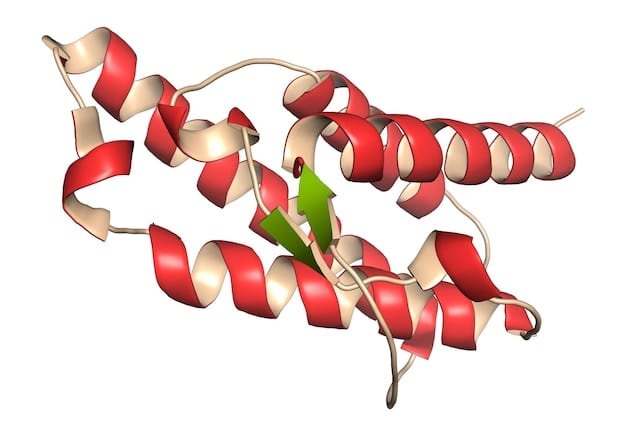Increase Bench Press by 20%: Scientifically Proven Routine

Achieving a 20% increase in your bench press requires a strategic, scientifically-backed approach that integrates progressive overload, optimized recovery, and precise nutritional support to maximize strength adaptations and foster consistent gains over time.
For many, the bench press is more than just an exercise; it’s a benchmark of upper body strength and a symbol of dedication in the gym. While the quest for a stronger bench can often feel like an uphill battle, a scientifically proven routine to increase bench press by 20% is not merely a pipe dream, but an achievable reality through a methodical and informed approach. This guide distills complex physiological principles into actionable strategies, moving beyond guesswork to provide a clear pathway for significant strength gains.
Understanding the Science of Strength Adaptation
To really boost your bench press, you need to grasp how your body actually gets stronger. It’s not just about lifting more weight; it’s about stimulating your muscles and nervous system in specific ways so they adapt and grow. This process, known as strength adaptation, involves several key physiological mechanisms working in concert.
Firstly, mechanical tension is paramount. This refers to the force placed on your muscle fibers during an exercise. When you lift heavy in the bench press, your muscles experience high levels of tension, signaling them to become stronger. Secondly, muscle damage, or micro-tears within the muscle fibers, triggers a repair process that leads to muscle growth, known as hypertrophy. While some damage is beneficial, excessive damage can impede recovery and progress. Lastly, metabolic stress, which is the accumulation of byproducts like lactate during high-rep sets, also contributes to muscle growth by activating cellular signaling pathways.
Neuromuscular Efficiency
Beyond muscle growth, improving your neuromuscular efficiency is crucial for bench press gains. This involves the ability of your brain and central nervous system (CNS) to recruit and coordinate muscle fibers effectively. Think of it as fine-tuning the communication between your mind and your muscles, allowing them to work together more powerfully and efficiently.
- Motor Unit Recruitment: Training with heavier loads teaches your CNS to activate more motor units (a motor neuron and the muscle fibers it innervates), including high-threshold motor units, which are responsible for generating maximal force.
- Rate Coding: This refers to the speed at which your CNS sends signals to your muscle fibers. Faster rate coding means more rapid and forceful contractions, directly translating to stronger lifts.
- Intermuscular Coordination: The bench press is a compound movement, meaning it involves multiple muscle groups working together – your chest, shoulders, and triceps. Improved intermuscular coordination ensures these groups fire in a synchronized and optimal manner, reducing energy waste and maximizing force production.
Optimizing these processes requires a balanced approach to training, incorporating elements of heavy lifting for mechanical tension and neuromuscular adaptation, moderate loads for hypertrophy and metabolic stress, and proper recovery to allow for adaptation. Neglecting any one of these components will limit your potential for a 20% increase in your bench press.
Moreover, the concept of progressive overload is fundamental. This principle dictates that for muscles to continue to grow stronger, they must be continually challenged with new stimuli. This can mean increasing the weight, reps, sets, decreasing rest times, or improving technique. Without consistently challenging your body to adapt, strength plateaus are inevitable.
Building Your Weekly Bench Press Routine
A successful bench press routine isn’t about lifting as heavy as possible every day; it’s about intelligent programming that balances intensity, volume, and frequency. To aim for a 20% increase, a carefully structured weekly plan is essential, focusing on progressive overload and variations that target specific weaknesses.
Our proposed routine incorporates elements of maximum strength training, hypertrophy work, and accessory exercises, ensuring a comprehensive approach to bench press development. The frequency will typically involve training the bench press 2-3 times per week, allowing for adequate recovery while providing sufficient stimulus for growth. Each session should have a clear purpose, contributing to the overall goal of increased strength and muscle mass.
Structured Training Sessions
Here’s a breakdown of how your weekly bench press training might look, focusing on heavy lifts, volume, and technique:
- Day 1: Heavy Strength Focus
This session is dedicated to lifting heavy, aiming to improve your maximal strength and neuromuscular efficiency. After a thorough warm-up, perform sets with challenging weights, staying within a low rep range (e.g., 3-5 reps). The goal here is to handle considerable load, even if it means fewer repetitions. Focus intensely on perfect form and controlled negatives.
- Day 2: Volume & Hypertrophy Focus
On this day, the emphasis shifts to accumulating volume to promote muscle growth. You’ll use moderate weights for higher rep ranges (e.g., 6-10 reps), focusing on a strong mind-muscle connection. This session helps build the muscular foundation necessary to support heavier lifts on strength days. Incorporate variations like close-grip bench press or incline bench to hit the chest from different angles.
- Day 3: Speed & Technique (Optional but Recommended)
If you opt for three bench days, this session should focus on speed work and refining your technique with lighter weights. Explosive reps (e.g., 6-8 reps at 50-60% of your 1RM, performed quickly) improve power and bar speed, which translates to easier heavy lifts. This day is crucial for reinforcing good form and addressing any technical flaws without the fatigue of maximal loads.
Remember that adequate rest between sets is crucial, especially on heavy days. For strength work, take 3-5 minutes to ensure full recovery. For hypertrophy, 60-90 seconds may suffice. Listening to your body and adjusting based on energy levels and recovery is also an important aspect of a sustainable program. The total volume (sets x reps x weight) should incrementally increase over time, adhering to the principle of progressive overload.

The progression within this routine is critical. Do not attempt to add 20% to your max overnight. Instead, aim for small, consistent increases in weight, reps, or sets week by week. This could mean adding 2.5-5 pounds to your lifts, performing an extra rep on your last set, or adding an extra set to a specific exercise. These micro-progressions accumulate over time, leading to significant macro-progressions in your bench press strength.
The Crucial Role of Accessory Exercises
While the bench press itself is king, neglecting accessory exercises is a common mistake that can hinder progress and increase the risk of injury. These supplementary movements are vital for strengthening supporting muscle groups, addressing weaknesses, and promoting overall muscular balance. They help to build a robust foundation that directly translates to a stronger and safer bench press.
Accessory exercises can be categorized by the primary muscle group they target or the specific aspect of the bench press movement they enhance. For instance, some focus on triceps strength, which is often a limiting factor at the lockout phase of the bench press, while others bolster shoulder stability or chest development.
Targeted Accessory Movements
Here are some of the most effective accessory exercises to complement your bench press routine:
- Triceps Focus:
- Close-grip Bench Press: This variation places greater emphasis on the triceps and inner chest, directly improving lockout strength. Perform with a slightly narrower grip than your standard bench press.
- Dumbbell Triceps Extensions (Skullcrushers): Excellent for isolating the triceps and building mass. Focus on controlled eccentric (lowering) movements.
- Shoulder Health & Strength:
- Overhead Press (Dumbbell or Barbell): Improves overall shoulder strength and stability, crucial for supporting heavy bench presses.
- Face Pulls: Reverses the internal rotation caused by extensive pressing, promoting shoulder health and posture. Essential for preventing imbalances.
- Chest Development & Stability:
- Dumbbell Bench Press: Allows for a greater range of motion and helps address muscular imbalances between sides.
- Dumbbell Flyes: Excellent for chest isolation and stretching the pectoral muscles, promoting hypertrophy.
- Back & Core Strength:
- Rows (Barbell, Dumbbell, Cable): Strong lats are crucial for stability during the bench press, helping to create a stable base and transfer force.
- Plank Variations: A strong core provides a stable platform for performing heavy lifts, enhancing power transfer from your lower body to your upper body.
The selection of accessory exercises should be individualized based on your specific weaknesses. If you struggle at the bottom of the bench press, focus on movements that build chest strength and lockout power from a dead stop. If your triceps give out before your chest or shoulders, prioritize triceps isolation exercises. Regularly assess your form and sticking points to determine which accessory exercises will yield the greatest benefit for your specific needs.
Integrating these exercises into your routine means they should typically be performed after your main bench press sets. Aim for 2-4 sets of 8-12 repetitions for most accessory lifts, maintaining good form and a controlled tempo. The volume should be manageable, supplementing your main lifts without causing excessive fatigue that hinders your recovery for subsequent bench press sessions. Strategic inclusion of these movements will not only help you increase bench press by 20% but also build a more resilient and balanced physique.
Optimizing Nutrition for Performance and Recovery
Training hard is only half the battle; what you put into your body plays an equally critical role in your ability to recover, adapt, and ultimately, increase your bench press by 20%. Nutrition isn’t just about weight loss or gain; it’s about providing your body with the building blocks and energy it needs to perform, repair, and grow stronger.
For strength athletes, the focus shifts to adequate protein intake for muscle repair, sufficient carbohydrates for energy replenishment, and healthy fats for hormonal balance and overall health. Overlooking any of these macronutrients can lead to stagnation in performance or slower recovery from intense training sessions.
Macronutrient Breakdown
- Protein: The Muscle Builder
Protein is paramount for muscle protein synthesis, the process by which your body repairs and rebuilds muscle fibers damaged during exercise. Aim for 0.7-1 gram of protein per pound of body weight daily, distributed throughout the day. Good sources include lean meats, poultry, fish, eggs, dairy, and plant-based options like legumes and tofu.
- Carbohydrates: The Energy Source
Carbohydrates are your body’s preferred fuel source, especially for high-intensity activities like lifting. They replenish muscle glycogen stores, which are depleted during strenuous workouts. Insufficient carbohydrate intake can lead to fatigue, poor performance, and compromised recovery. Focus on complex carbohydrates such as whole grains, fruits, and vegetables.
- Fats: Hormonal Support & Health
Healthy fats are essential for hormone production, nutrient absorption, and overall cellular function. While not a primary energy source during weightlifting, they contribute to satiety and overall well-being. Incorporate sources like avocados, nuts, seeds, olive oil, and fatty fish into your diet.
Beyond macronutrients, micronutrients – vitamins and minerals – play supporting roles in numerous bodily functions, including energy production, muscle contractions, and immune health. Ensure a varied diet rich in fruits, vegetables, and whole foods to meet your micronutrient needs. Consider a multivitamin if your diet is consistently lacking in certain areas, but prioritize whole food sources.
Hydration is another often-overlooked component of performance and recovery. Dehydration can significantly impair strength, endurance, and cognitive function. Drink plenty of water throughout the day, and consider electrolyte-rich beverages during and after intense workouts, especially in hot conditions. Pay attention to your body’s signals and adjust your intake accordingly based on activity level and climate.
The Indispensable Role of Recovery and Sleep
You don’t get stronger when you’re lifting weights; you get stronger when you’re resting. This fundamental principle underscores the critical importance of recovery and sleep in any effective strength training program. Neglecting these aspects can negate the benefits of even the most perfectly designed routine, leading to overtraining, performance plateaus, and increased risk of injury.
Recovery is not just about taking a day off from the gym; it encompasses a range of strategies that help your body repair muscle tissue, replenish energy stores, and adapt to the stress of training. Quality sleep, active recovery, and stress management are all integral components that contribute to your overall progress toward increasing your bench press by 20%.
Prioritizing Sleep
Sleep is arguably the most powerful recovery tool at your disposal. During deep sleep cycles, your body releases growth hormone, which is vital for muscle repair and growth. It’s also when your central nervous system recovers from the demands of heavy lifting. Aim for 7-9 hours of quality sleep per night. Creating a consistent sleep schedule and optimizing your sleep environment can significantly impact your recovery capacity.
- Consistent Sleep Schedule: Go to bed and wake up at roughly the same time each day, even on weekends, to regulate your body’s internal clock.
- Optimize Your Environment: Ensure your bedroom is dark, quiet, and cool. Avoid screens (phones, tablets, computers) before bed, as the blue light can disrupt melatonin production.
- Pre-Sleep Routine: Engage in relaxing activities before bed, such as reading, light stretching, or a warm bath, to signal to your body it’s time to wind down.

Active Recovery and Stress Management
Active recovery involves low-intensity activities that promote blood flow to sore muscles without adding significant stress. This can include light cardio, stretching, foam rolling, or mobility work on rest days. These activities help flush out metabolic waste products and deliver nutrients to fatigued muscles, speeding up the recovery process.
Stress, whether physical or psychological, elevates cortisol levels, a hormone that can hinder muscle growth and recovery. Managing stress through mindfulness, meditation, hobbies, or spending time in nature is crucial. Chronic stress can impair sleep quality and diminish your body’s ability to adapt to training. Regularly incorporating relaxation techniques into your daily routine can yield significant benefits not just for your training, but your overall well-being. Remember, a strong body requires a clear mind and a well-rested system.
Failure to prioritize recovery will inevitably lead to diminishing returns, plateaued strength gains, and potentially even regression. It’s not about how much you can push yourself, but how well you allow your body to bounce back. By treating recovery as an equally important part of your training as the actual lifting, you lay the groundwork for sustainable and significant strength increases in your bench press.
Addressing Potential Plateaus and Troubleshooting
The journey to increasing your bench press by 20% is rarely a linear one. Plateaus are an inevitable part of strength training, signaling that your body has adapted to the current stimulus and requires a new challenge. Recognizing a plateau and effectively troubleshooting it is crucial for continued progress. This involves critically evaluating your training, recovery, and nutrition, and implementing strategic adjustments.
A plateau isn’t a sign of failure but an opportunity for intelligent programming. The key is to avoid simply doing “more” of the same, which can lead to overtraining and burnout. Instead, consider what might be limiting your progress and address it directly with targeted interventions.
Strategies to Break Through Plateaus
- Vary Rep Ranges and Intensity: If you’ve been consistently training in the same rep range, switch it up. Incorporate periods of very heavy, low-rep training (1-3 reps) to improve max strength, followed by phases of higher-rep, moderate-weight training (8-12 reps) for hypertrophy. Periodization, or systematically varying training stimuli over time, is a powerful tool to prevent adaptation.
- Introduce Bench Press Variations: As discussed, exercises like close-grip bench, incline bench press, floor press, or pause bench press can target specific sticking points and build supporting muscles without the full neurological fatigue of your main bench press.
- Deload Weeks: Every 4-8 weeks, incorporating a deload week—reducing training volume and intensity significantly—allows your body to fully recover and supercompensate. This can lead to a surge in strength when you return to full training.
- Assess Weak Points:
- Sticking at the Bottom: This usually indicates a weakness in your chest or initial drive from the chest. Focus on pause reps, where you hold the bar motionless on your chest for 1-3 seconds before pressing. Also, strengthen your chest with dumbbell flyes or dips.
- Sticking Midway/Lockout: This often points to triceps weakness. Emphasize close-grip bench press, dumbbell triceps extensions, and board presses (pressing off a board on your chest to shorten the range of motion and overload the lockout).
- Increase Training Frequency: If you’re only benching once a week, increasing frequency to 2-3 times can provide more stimulus. However, ensure adequate recovery between sessions.
- Optimize Nutrition and Sleep: Revisit your diet and sleep hygiene. Are you getting enough protein, carbohydrates, and quality sleep? These foundational elements can often be overlooked when troubleshooting, but addressing them can unlock new gains.
- Improve Technique: A slight tweak in your setup, arch, grip width, or bar path can significantly improve leverage and power. Consider recording your lifts and reviewing your form, or seek feedback from an experienced coach. Even small technical improvements can yield disproportionately large strength gains.
It’s important to be patient and systematic when implementing these troubleshooting strategies. Don’t change everything at once. Introduce one or two new variables, give your body time to adapt (typically 2-4 weeks), and assess the results. Maintaining a training log is invaluable for tracking progress, identifying patterns, and making informed decisions about your routine. By taking a proactive and intelligent approach to plateaus, you can continue to make consistent progress and achieve that ambitious 20% increase in your bench press.
Long-Term Progression and Sustainability
Achieving a 20% increase in your bench press is a significant accomplishment, but the journey doesn’t end there. True strength development is a continuous process, requiring a commitment to long-term strategies and a sustainable approach to training. The goal should not just be a temporary peak, but consistent progress that can be maintained over years, not just weeks or months.
Sustainability in training means avoiding burnout, minimizing injury risk, and making fitness an integral part of your lifestyle. This often involves periods of more intense training followed by phases of maintenance or lower intensity, a concept known as periodization. It’s about working smarter, not just harder, and understanding that progress isn’t always linear.
Maintaining and Building Upon Gains
- Cyclical Periodization: Instead of aiming for peak performance year-round, structure your training into cycles. This might include:
- Accumulation Phases: Higher volume, moderate intensity to build muscle mass and work capacity.
- Intensification Phases: Lower volume, higher intensity to maximize strength.
- Deload/Taper Phases: Reduced volume and intensity for recovery and supercompensation.
This approach helps manage fatigue and prevents plateaus by continually introducing new stimuli.
- Listen to Your Body: Learn to differentiate between muscle soreness and pain. Don’t push through actual pain, as this is a fast track to injury. If you feel exceptionally fatigued or rundown, a spontaneous rest day or a mini-deload might be more beneficial than forcing a workout.
- Focus on Longevity: Incorporate mobility work, stretching, and prehabilitation exercises (exercises designed to prevent injuries) into your routine. Developing a strong, balanced, and mobile body will allow you to continue lifting effectively for years to come.
- Enjoy the Process: Find joy in the training itself, not just the numbers on the bar. Set new, exciting goals not only for strength but also for overall fitness, body composition, or trying new exercises. A sustainable fitness journey is one you enjoy and look forward to.
Building a strong bench press, and indeed any strength attribute, is a marathon, not a sprint. Celebrate your milestones, but always look forward to the next challenge. By understanding the science of adaptation, implementing intelligent programming, prioritizing recovery, and committing to a sustainable long-term approach, you can not only achieve your 20% increase but continue to build strength and resilience for a lifetime.
The principles outlined in this guide provide a robust framework. However, individual results will vary, and it’s essential to adapt these guidelines to your own body, schedule, and goals. Consulting with a qualified strength coach or healthcare professional can provide personalized guidance and ensure you train safely and effectively. Embrace the journey, trust the process, and consistently put in the work, and those bench press gains will surely follow.
| Key Point | Brief Description |
|---|---|
| 📈 Progressive Overload | Consistently challenge muscles with increased weight, reps, or volume for continuous growth. |
| 🍽️ Optimized Nutrition | Adequate protein, carbs, and healthy fats are crucial for muscle repair, energy, and recovery. |
| 😴 Quality Recovery | Prioritize 7-9 hours of sleep and active recovery to allow muscles and CNS to repair and adapt. |
| 🛠️ Accessory Work | Strengthen supporting muscles (triceps, shoulders, back) to address weaknesses and prevent injury. |
Frequently Asked Questions
▼
The timeline depends on your current strength level, consistency, and adherence to the program. For beginners, a 20% increase might be achievable in 3-6 months. For intermediate lifters, it could take 6-12 months. Advanced lifters might require even longer, as gains become harder to come by. Consistency, proper nutrition, and recovery are key factors.
▼
Yes, for most individuals, bench pressing three times a week can be safe and highly effective, provided the intensity and volume are properly managed through periodization. It is crucial to vary the focus of each session (e.g., heavy, volume, speed) and ensure adequate recovery and nutrition. Listen to your body and adjust as needed to prevent overtraining.
▼
One of the most common mistakes is neglecting accessory exercises for supporting muscle groups like the triceps, shoulders, and upper back. Another frequent error is failing to incorporate progressive overload by sticking to the same weights and reps without challenging the muscles. Inadequate recovery and poor nutrition also severely hinder progress.
▼
Proper form is paramount for both maximizing gains and preventing injury. Incorrect form can limit the amount of weight you can lift and shift stress to less stable joints, increasing injury risk. It also ensures the target muscles (chest, triceps, shoulders) are effectively engaged, leading to more efficient strength adaptation and better long-term progress.
▼
Supplements can support your goals, but they are not a substitute for consistent training, proper nutrition, and adequate recovery. Creatine monohydrate is scientifically proven to enhance strength and power. Protein powder can help meet daily protein intake goals. However, focus on your foundational training and dietary habits first; supplements are merely an addition.
Conclusion
Achieving a 20% increase in your bench press is a testament to consistent effort, intelligent programming, and a holistic approach to strength training. It transcends merely lifting heavier weights; it’s about understanding the intricate interplay of physiological adaptation, meticulous execution of a scientifically proven routine, optimized recovery, and precise nutritional support. By diligently applying the principles of progressive overload, incorporating targeted accessory work, prioritizing restful sleep, and nourishing your body effectively, you not only elevate your strength but also cultivate a robust and resilient physique. This journey demands dedication, patience, and commitment to the process, but the rewards of newfound strength and resilience are undeniably worth the effort.





